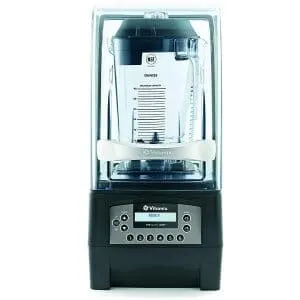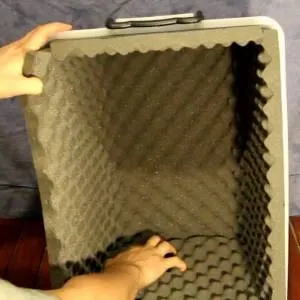 Have you ever wondered how to make a DIY blender sound enclosure? It isn’t as hard as you may think. It’s also not that hard to soundproof your blender using a few different types of methods. It doesn’t matter what kind of blender you have, they can all be improved. If you take a bit of time to build a sound enclosure, you can have a much more relaxing time in the kitchen.
Have you ever wondered how to make a DIY blender sound enclosure? It isn’t as hard as you may think. It’s also not that hard to soundproof your blender using a few different types of methods. It doesn’t matter what kind of blender you have, they can all be improved. If you take a bit of time to build a sound enclosure, you can have a much more relaxing time in the kitchen.
But there is more to it than just building a sound enclosure out of wood. You can take additional steps to lessen the noise your blender makes. I don’t need to explain to you how important this is for someone using a blender at their business, as you always want the customers to be comfortable without a noisy blender putting them off.
At home, having a silent blender means you can make your morning smoothie or milkshake without disturbing anyone else, and you can use your blender at any time of the day without irritating even yourself! Nobody likes listening to the roar of an angry blender, and by implementing some of the tricks I’m about to tell you, you can stop covering your ears every time you turn on your blender.
A lot of the noise coming from your blender is due to vibration and position. The motor is too strong, and it vibrates your machine, and all that vibrating echoes off your countertop and rings loudly in your ears. We are going to focus on minimizing the vibration and encasing your blender in something solid using a DIY blender sound enclosure to minimize noise.
Read More: Is Your Ninja Blender Loud? 7 Tips to Make it Quieter
Relocate Your Blender
Sometimes you can lessen the noise your blender makes by simply putting it in a different spot. For example, if your blender is placed close to a wall, try putting it somewhere else. The reverberation of your blender vibrating goes off the wall and amplifies the noise. Try putting your blender in the center of the counter and away from the wall. This will help to reduce the level of noise.
Use a Towel
By putting a towel beneath your blender, you can reduce the noise that comes from vibration. Try to use a thick towel, and just keep it underneath your blender so that it doesn’t vibrate off the countertop. The towel will absorb the sound rather than all the vibrations bouncing off the counter and being amplified throughout the kitchen. This is just like how a carpet works on your floor when it comes to the sound of footsteps.
Use a Rubber Mat
While towels do work for absorbing the sound vibrations, a rubber mat will work even better. Plus, a rubber mat will actually protect your countertop from spills and other gross stuff, and you won’t need to wash the rubber mat as much as the towel. A rubber mat will also look much more professional in your kitchen than a rubber mat.
Upgrade Your Blender
This may seem obvious, but it’s worth mentioning. If the noise from your blender is so bad that you have found your way to this article, you may want to invest in a silent blender. Vitamix does make one of the quietest blenders in the world, which is actually used all over the globe by Starbucks. You may want to invest in one of these types of blenders to reduce noise. Just keep in mind it could cost you around $1000 dollars for this type of blender.
Purchase a Sound Enclosure
We will talk about building your own DIY sound enclosure, but if you’re lazy like me you might just want to buy one. It doesn’t cost a ton of money, and you don’t even need to get a special fit. You can just buy a sound enclosure that will go over your blender and trap the sound during its blending cycle.
If you are using a Vitamix blender, you can buy a sound enclosure properly suited to your actual blender from the same company. But if you don’t have a Vitamix blender, you may need to buy an all-purpose sound enclosure from the internet. These can be a hit or miss depending on the dimensions of your blender.
Read More: Blender Noise Reduction – 7 Tips To Make A Blender Quieter
DIY Blender Sound Enclosure – How to Build Your Own
 Building your own sound enclosure is a little bit like building a miniature house. You just need to build a small enclosure that can box in your blender. There are a handful of different materials you can use to make your sound enclosure, such as plastic, cardboard, or wood, but I highly suggest using something quality. Wood is probably the best, as cardboard and plastic are too flimsy.
Building your own sound enclosure is a little bit like building a miniature house. You just need to build a small enclosure that can box in your blender. There are a handful of different materials you can use to make your sound enclosure, such as plastic, cardboard, or wood, but I highly suggest using something quality. Wood is probably the best, as cardboard and plastic are too flimsy.
Start by measuring how big you are going to need your enclosure. It should be wide enough that you can slide your blender in and out of the enclosure easily without pinching your fingers. Get your dimensions and then cut four pieces of wood.
You need the base, the two walls, and the back wall. The top and front should be completely open. You should also be able to reach the top of the blender easily without having to sneak your fingers between the blender and the walls.
Now you need to build your door, otherwise, you’ll just be amplifying the sound outwards like cupping a headphone in your fist. Keep in mind that if you really want the sound to be almost gone, you should insulate the base and the walls in Styrofoam. You can easily cut Styrofoam to length and glue it to the wood.
Measure your top and front panels, then screw them together. But don’t screw them to the rest of the enclosure. You’ll need to purchase a small hinge from your local hardware store and install the hinge on the rear wall, then attach the hinge to your top panel. Now you have a swinging door!
To use your blender, simply keep it inside the enclosure. Swing the door up to access your blender container, and when it’s time to blend you can just let the door close shut. No more noise!
